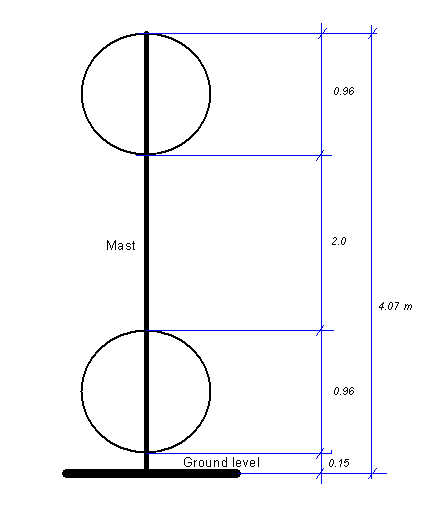Many thanks to SWLing Post contributor, Harald Kuhl (DL1AX), who shares the following article on LZ1AQ’s website:
Published on: 2018/11/20, Rev. 1.0 July 2018, Rev. 1.1 Nov 2018
Author: Chavdar Levkov LZ1AQ
Setup
Two identical small loops were placed one above the other according to Fig.1. One of the loops is very low – almost on the ground. The other one is placed at height which usually is used by the loop users. Two AAA-1C wideband active antenna amplifiers were used. Their gain difference was not more than 0.3 dB. The feeder was FTP cable each 20 m long. No cable baluns were used. The outputs were connected through two way antenna switch to a SD RX (Perseus). I used a measurement technique described in – A Periodic Switching Technique to Compare Receiving Antenna Performance in the Presence of Strong Fading. This is a precise method to compare two receiving antennas with real sky wave signals and the resolution can be less than a decibel. The idea is to switch periodically between two antennas and to estimate their difference on a calibrated graphic strength meter of a SD radio.[…]
Click here to read the full article.
I’ve often assumed height had little effect on the performance of an HF loop antenna–this evaluation seems to support that theory. Thanks for sharing this, Harald!


I wish to use a 80-meter horizontal loop antenna at 45 Feet. How far away from my 100-foot high, 10 through 40 antennae, do I need to be?
I appreciate when someone double–checks statements made by someone else, like “height is of little concern with SMLs”. FWIW, I compared an active SML at 3ft and ~25ft height a few years ago and came to the same conclusion. There was no difference in noise, and fringe case weak signals were pretty much the same, no appreciable difference in SNR, it was not worth taking the risk of higher wind loads etc. I also experimented with large(-ish) aperture loops and found they have similar properties. On frequencies <10 MHz my 60ft apex-up delta loop (feedpoint ~4-5ft) performs just as well as my dipole 30+ft AGL.
RonF, you made a good point about antenna symmetry – since I made these experiments at my not so RFI-free home location, differences in near-field noise pickup should've been obvious but there were none. Differences were more than obvious though with all asymmetric designs I tried there (end-fed, OCF dipole, verticals), which is why I believe that those designs don't fly anymore nowadays, they shouldn't even be considered in any other environment than the ITU "remote/rural" category with no houses within a 100ft circle around the antenna.
I gave a quick eyeball at the test, and while I may agree with the fact that signal levels may be almost the same, I think that it would be very interesting to measure noise AND s/n values since I believe that, while the higher loop may offer a similar signal level to the lower one, the first may have a significantly better s/n which in turn would mean being able to “read” a signal vs “just receiving” it
He does seem to touch on that, as he says “The band noise level was also measured at several frequencies as a power in 1KHz bandwidth at spots where there are no signals”. I agree, though, that that aspect isn’t specifically called out or addressed in his results.
From my fairly ad-hoc tests over several years, I don’t think there’s any substantial difference in background noise level or S/N ratio that can be attributed to loop antenna *height*. I _do_ suspect, based on my own rather anecdotal evidence, that other somewhat related factors – primarily antenna balance – can affect S/N ratio. So, for example, a vertically-oriented loop, near to the ground (or equivalent e.g. roof-mounted), with its coupling point at either bottom-centre or top-centre will have noticeably better S/N ratio than one with its coupling point half-way up one side.
My assumption is that is probably due to slight differences in the amount of coupling to the ‘ground’ between each half of the loop (i.e. the two paths from the feedpoint to the point opposite) unbalancing things, and so increasing noise pickup.
(As someone who is trained in designing, implementing, and testing models – scientific, that is!, albeit in a different field – I’m also wary of trusting things like NEC models too far. Models are *always* imperfect representations of reality; even for a ‘finished’ model (no such thing!) a good part of its utility lies in highlighting the things you don’t understand about the system you’ve modelled. Just as much, or more in fact, than their utility for predicting outcomes of a system…)